By: Justin Bons, Founder of Cyber Capital
Compiled by: Luffy, Foresight News
Solana has had the most dramatic comeback in crypto history and has been controversial since its inception. But it is no longer deserving of the stigma it has today. From the infamous FTX crash to fake usage metrics, centralized design, and downtime issues, Solana has been through a lot and has only gotten stronger through it. It has really changed, and it has forced us to change our views on it. Many people are keen to say Solana is bad; but in fact, we really should change our damn prejudices.
I blame myself for this, as I have to admit that I am partially responsible for this perception, as I was one of Solana’s harshest critics for many years. However, Solana is very different today than it was back then. Because of this, I transitioned from a Solana critic to a supporter in 2023.
In this article, we will dissect all of my past criticisms and demonstrate how Solana is better and why it deserves our support now. For the sake of decentralization and our shared cypherpunk values, changing your mind is not a weakness, it’s a superpower.
Downtime issues
Solana has experienced multiple outages, which is indeed worthy of our serious criticism. After all, a mature blockchain should theoretically never experience outages.
However, it is undeniable that Solana’s stability continues to improve. The key here is whether the changes at the technical level can give us sufficient reason to be confident in the future stability of its network.
Let’s first take a closer look at past outages and their root causes. The uptime charts for 2021 and 2022 are truly abysmal:
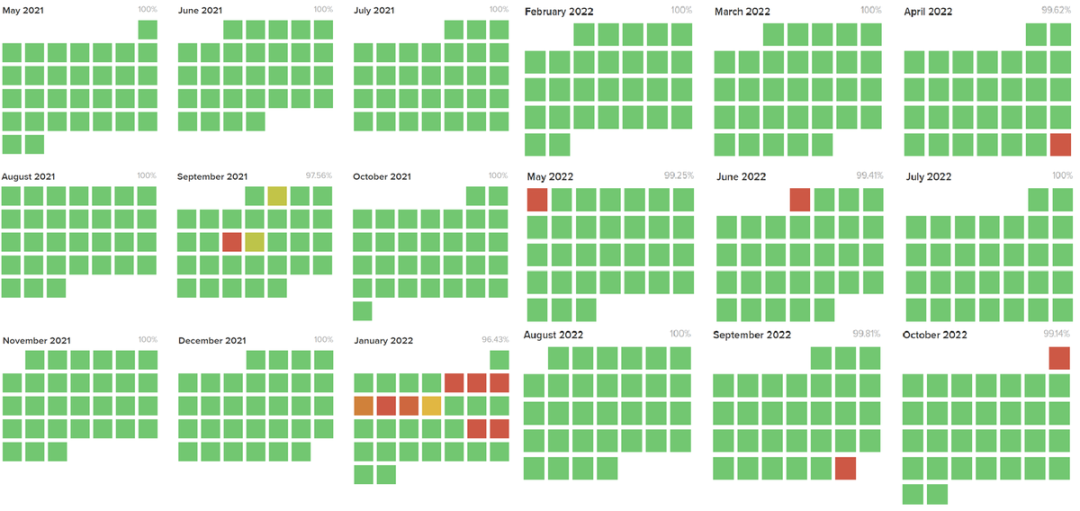
Source: Solana Status
On September 14, 2021, the Solana network was down for more than 20 hours. Due to excessive node memory usage, it was extremely difficult to restore network operation. On June 1, 2022, Solana was down again for more than 4 hours. This time it was caused by a transaction vulnerability, and the entire network came to a standstill. On October 1, 2022, Solana was down for more than 3 hours due to an invalid block causing a chain fork.
I won’t go into every Solana outage, as they are well documented elsewhere. Anyway, you can understand that this was a severe test for Solana, and it was in extremely poor condition and full of bugs. If it was still like this today, I would definitely still be critical. Instead, it has become stronger after each problem was solved. Now, let’s take a look at the follow-up:
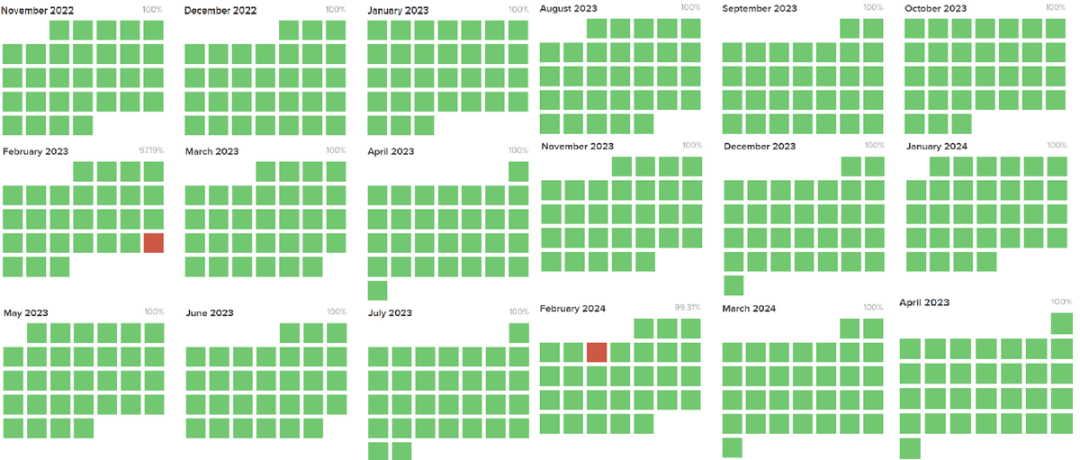
Source: Solana Status
The following year was a big improvement over the previous year, not perfect yet, but impressive progress. Most of these glitches were related to Solana’s lack of a robust fee market. The implementation of a fee market during this period was one of the main reasons I switched to Solana, as it paved the way for perfect stability the following year:

Source: Solana Status
However, Solana still has other issues: congestion, spam, RPC failures, network bottlenecks, etc. These are normal growing pains for a blockchain that is hitting new highs in usage. Importantly, there have been no downtime, which is a huge improvement over previous years and shows that Solana is maturing.
Fake TPS indicator
Now let’s talk about fake usage data: When I first pointed this out in 2021, Solana had almost no real usage. So when it claimed to have reached more than 40,000 TPS, it was a complete lie.
Since then, Solana has cleared up the misinformation in its external communications and no longer makes irresponsible claims about TPS; in fact, Solana’s leadership is now much more honest in its external communications.
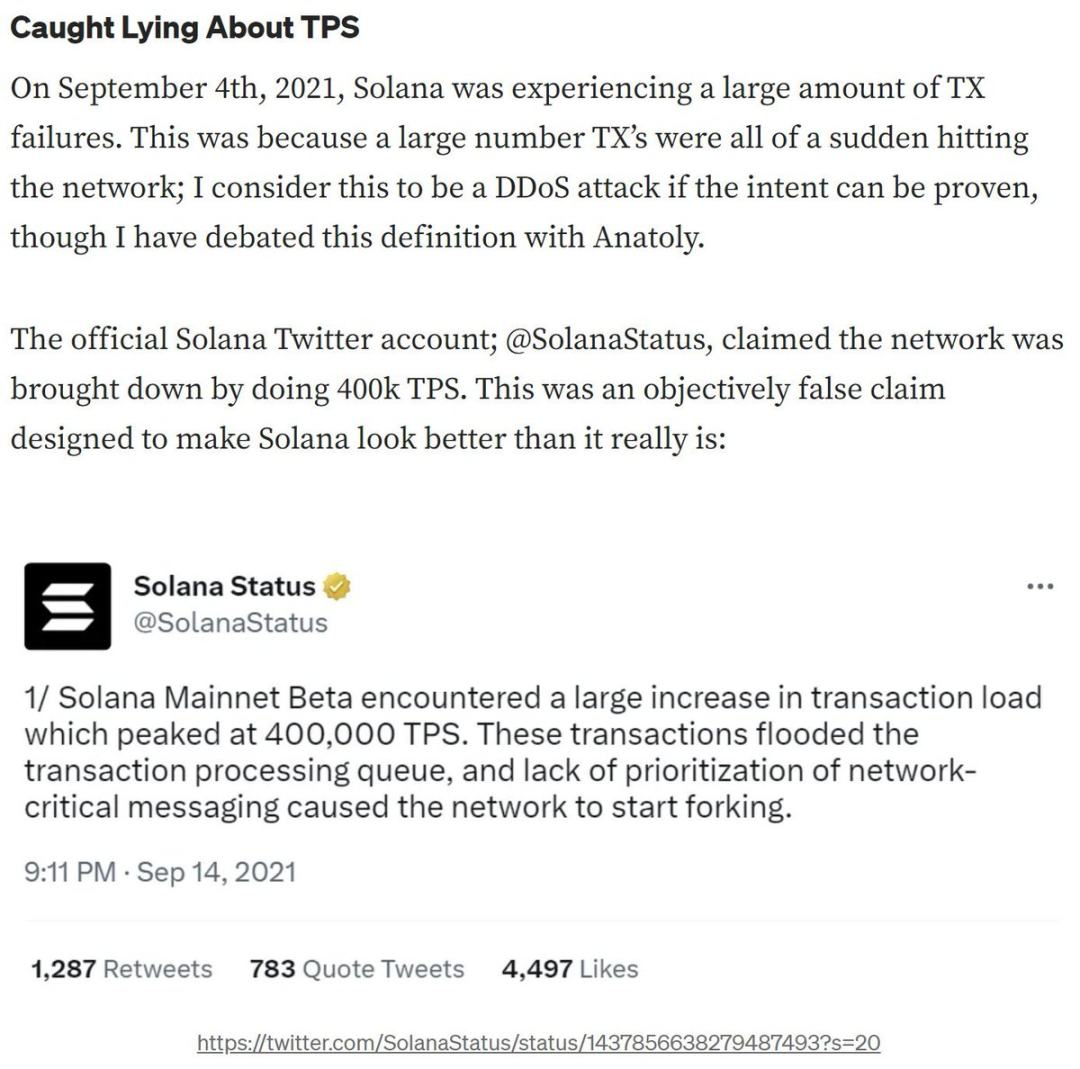
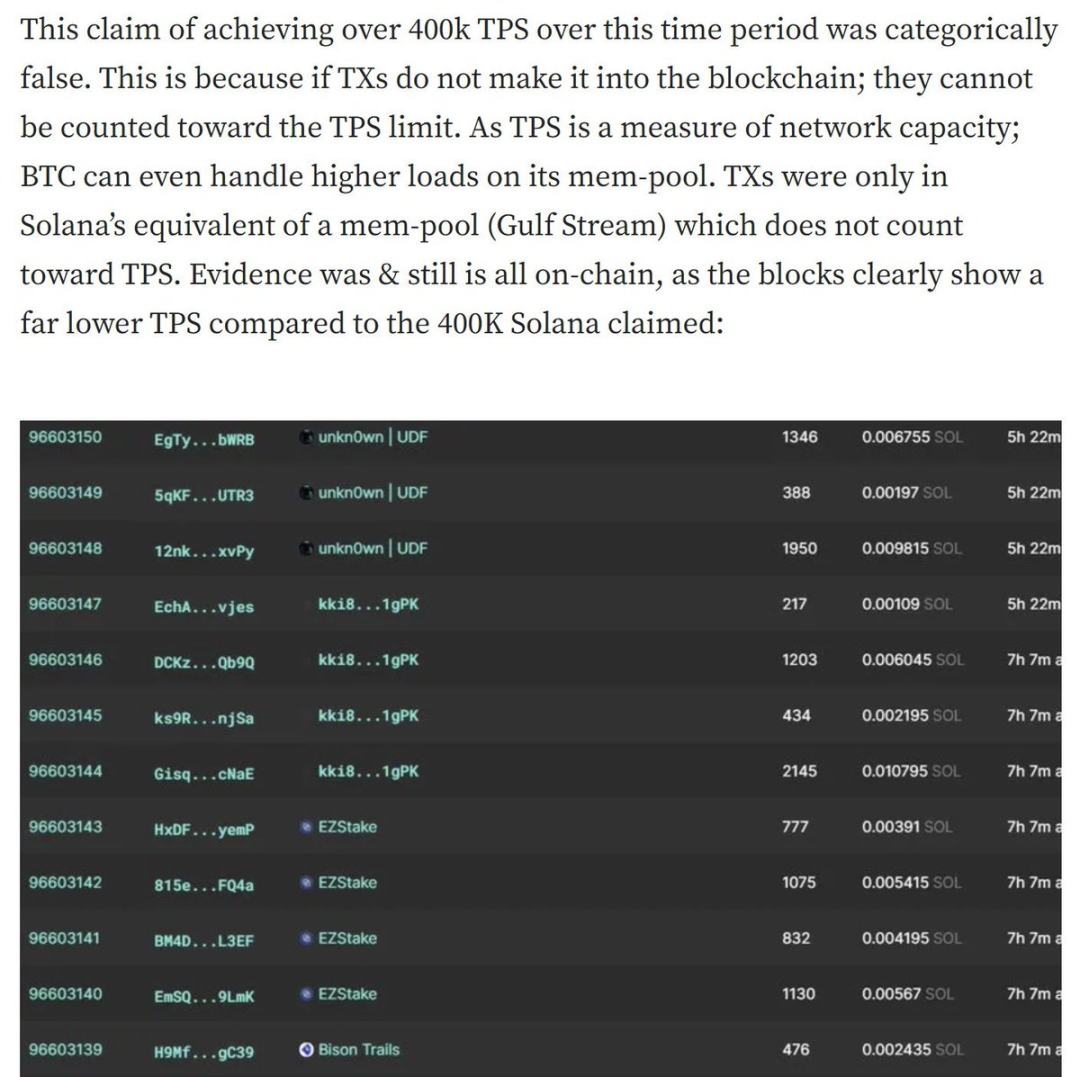
Even today, TPS data can still be misleading. According to the most conservative estimates, the adjusted numbers are still extremely impressive. Let me give you a detailed calculation, first the raw TPS, which is currently 4247:
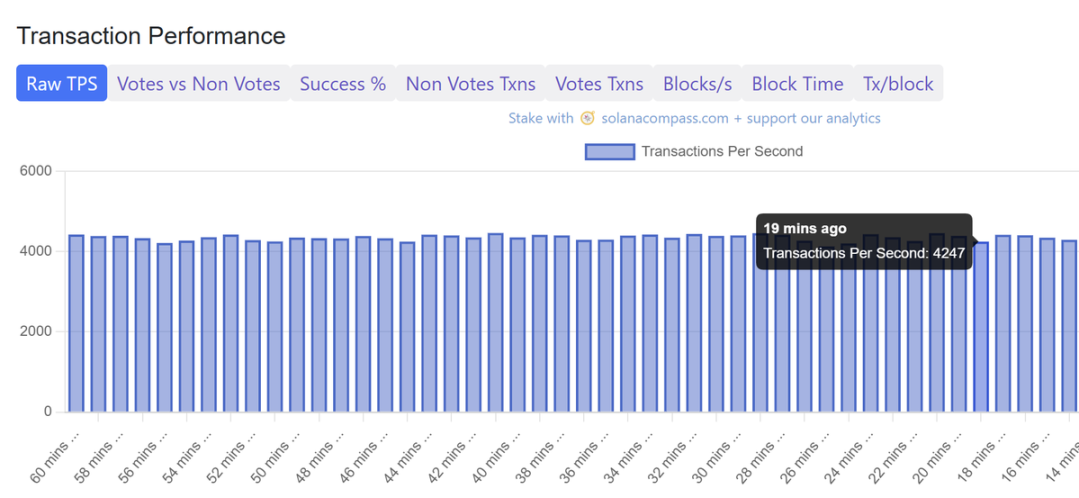
Source: Solana Compass
Now if we remove the voting transactions, we are left with 1109 TPS. For the sake of argument, we can also remove the “failed transactions”.
So, 4247 original TPS - voting transactions = 1109; then remove "failed transactions" (calculated as -40%) = 665.
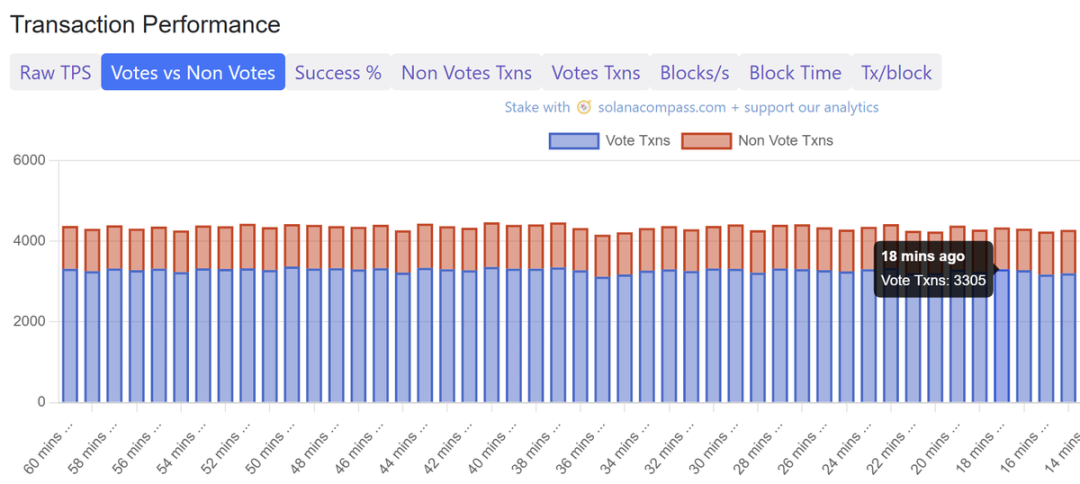
Source: Solana Compass
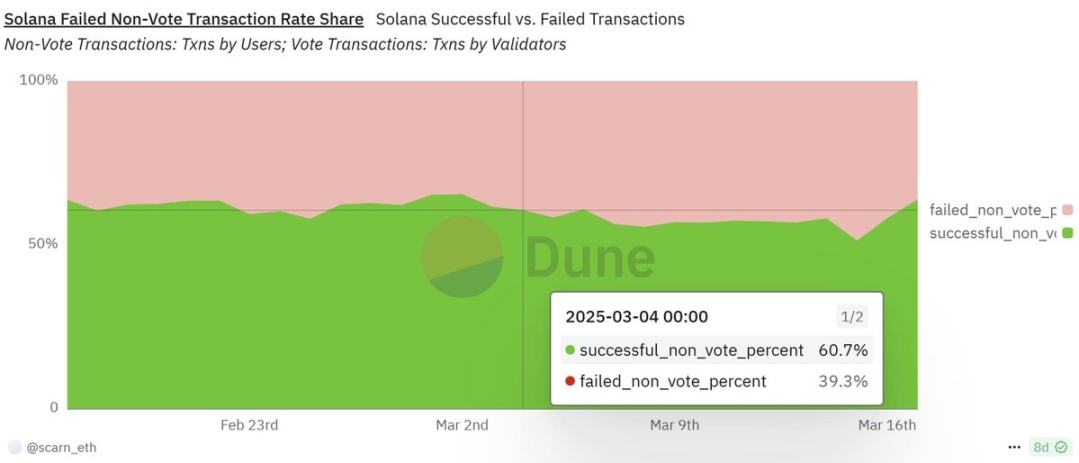
Source: Dune Analytics
This adjusted usage still far exceeds the combined total of all other blockchains today.
This makes Solana the clear leader in the decentralized application space, which is why some of the current criticism seems unfair, making it seem like Solana isn’t leading in usage, when it clearly is, even by the most conservative estimates.
Moreover, deducting "failed transactions" is not entirely reasonable, because these transactions are destined to fail and pay fees. These transactions are mainly driven by sophisticated actors who essentially double-spend to get their transactions included in the block faster, and expect most of them to fail. This does not reflect the transaction failure rate of ordinary users. According to my own testing, the transaction failure rate of ordinary users is less than 0.2%, which is within a completely reasonable range.
But for the sake of argument, even if we remove failed transactions, Solana still comes out on top.
Fake TVL Metrics
The same problem has been with TVL data, which has sometimes been greatly inflated:
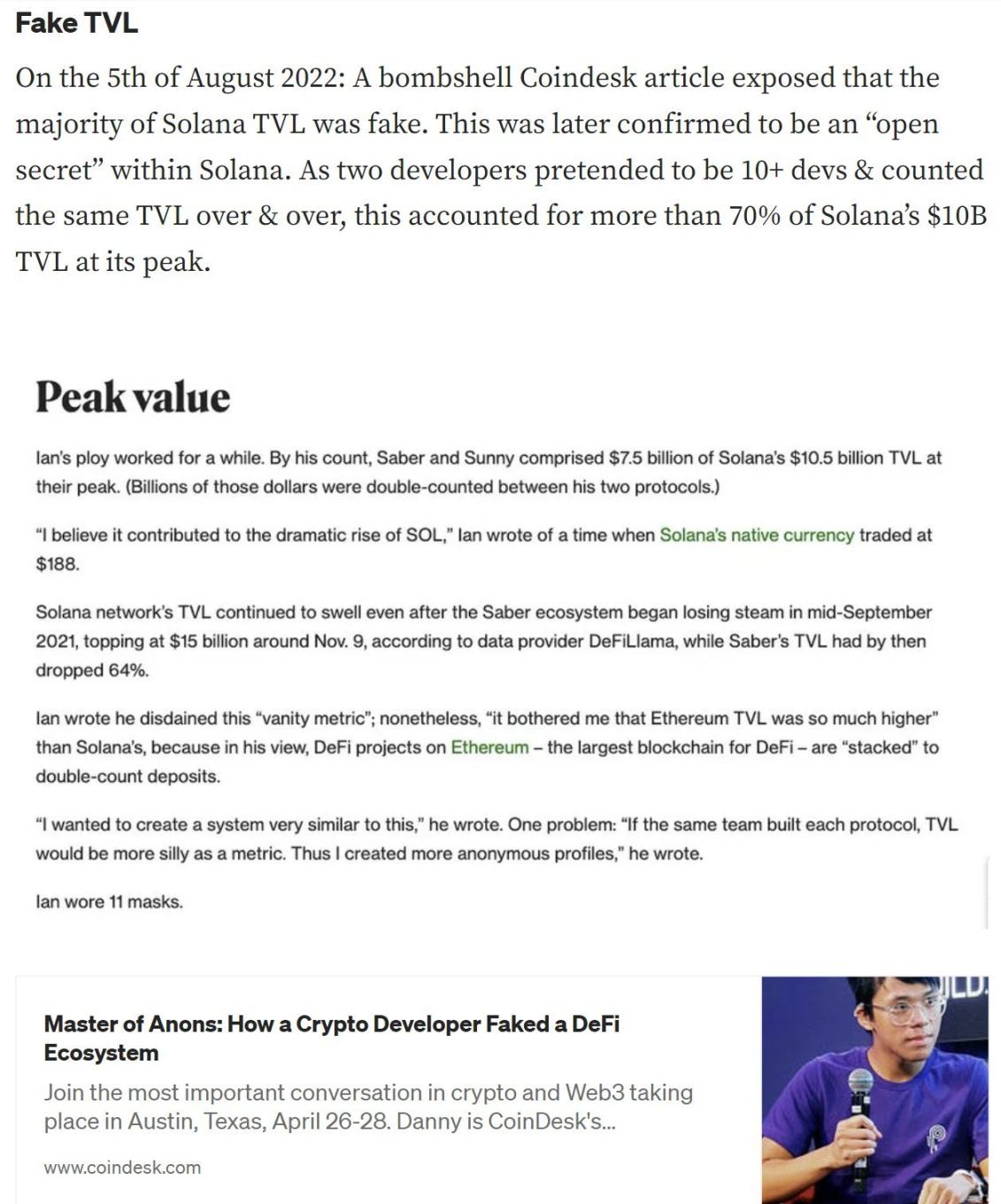
Fortunately, these are just growing pains as the ecosystem adjusts, and the TVL metric is now a fairer comparison, though not perfect, but no blockchain is perfect in the current way it’s measured. At least it’s fair to say that the blockchain ecosystem is now continuing to unify and apply the same standards.
Solana’s TVL is still a respectable $6 billion and growing rapidly, and the future looks bright:
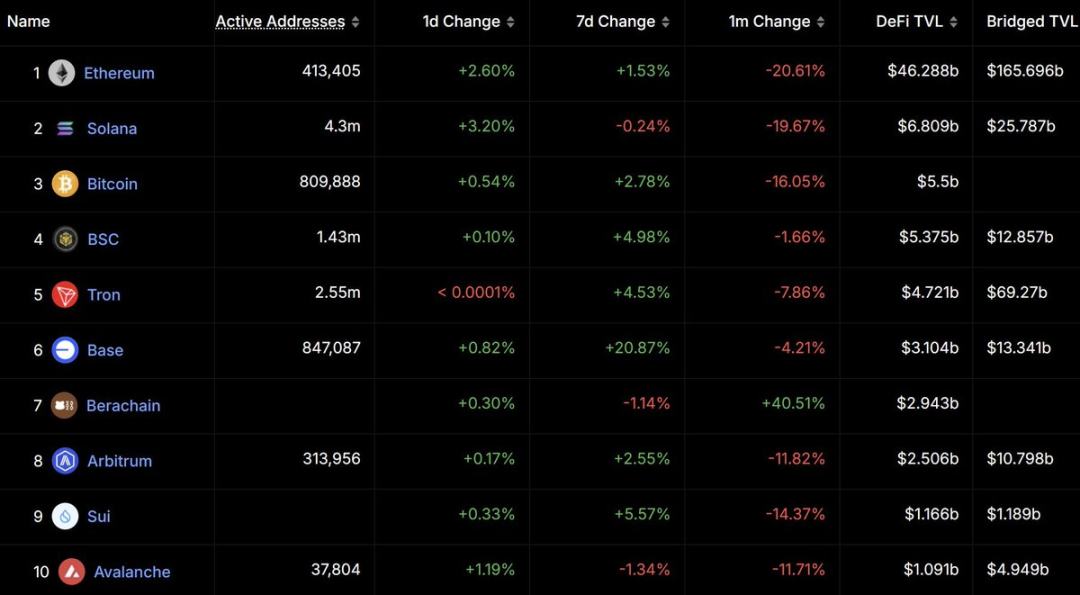
Source: DeFiLama
income
Even though L1 and DApp revenues are hitting new highs, many people are still unwilling to face reality.
What many people don’t understand is that revenue metrics cannot be faked because Solana is decentralized enough to ensure this.
The reason is that in order to “fake” these fees, the “brusher” has to pay all the fees out of his own pocket. Because there is no way to control which validators receive these fees, the “brusher” actually pays for all the fees, and the fee income cannot be faked.
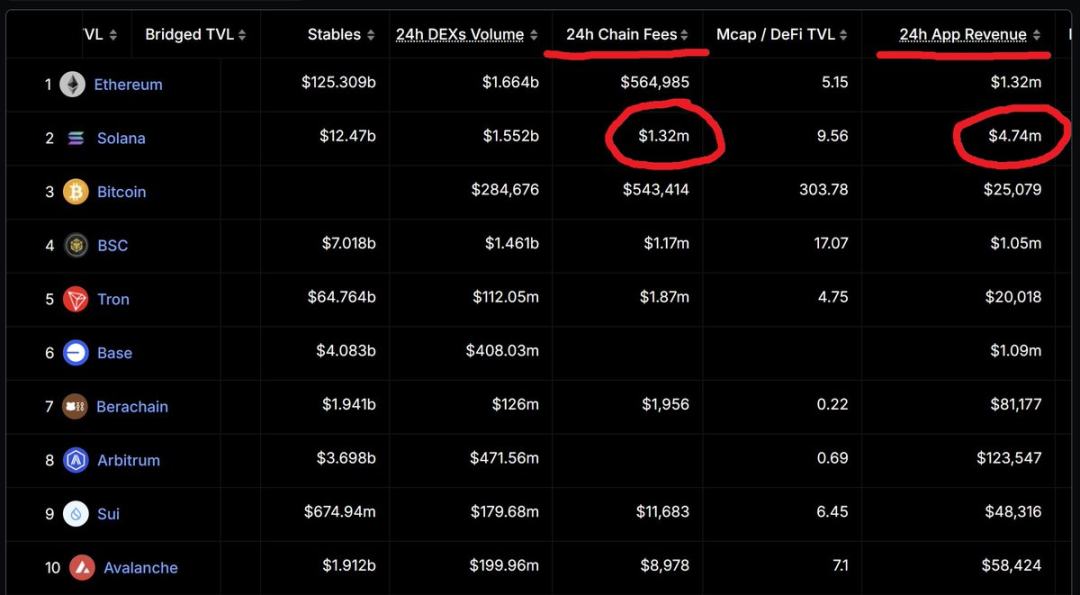
Source: DeFiLama
If someone thinks that Solana’s founders are spending up to $5 million a day to “fake” fee income, I really don’t know what to say to such people, this has already degenerated into a crazy conspiracy theory. Maybe I should suggest that such people take a look at their portfolio to see if there is any bias at work.
Revenue is arguably the most important metric because it demonstrates real-world use cases for cryptocurrencies while providing a solid, sustainable foundation for future decentralization and security.
Dangerous design trade-offs
Some of Solana's design decisions, such as Proof of History (PoH) and Turbine, do sacrifice a certain degree of decentralization for speed. Let's face it, what does this mean? In fact, this lowers the barrier to attack.
A rough estimate is that it may be reduced by about 20%. Nevertheless, this is only a small reduction in economic security. Because it allows the attacker to DDoS the next set of validators to become the leader, thereby reducing the amount of tokens required to launch a "51% attack". I explained this in more detail in my previous criticism:
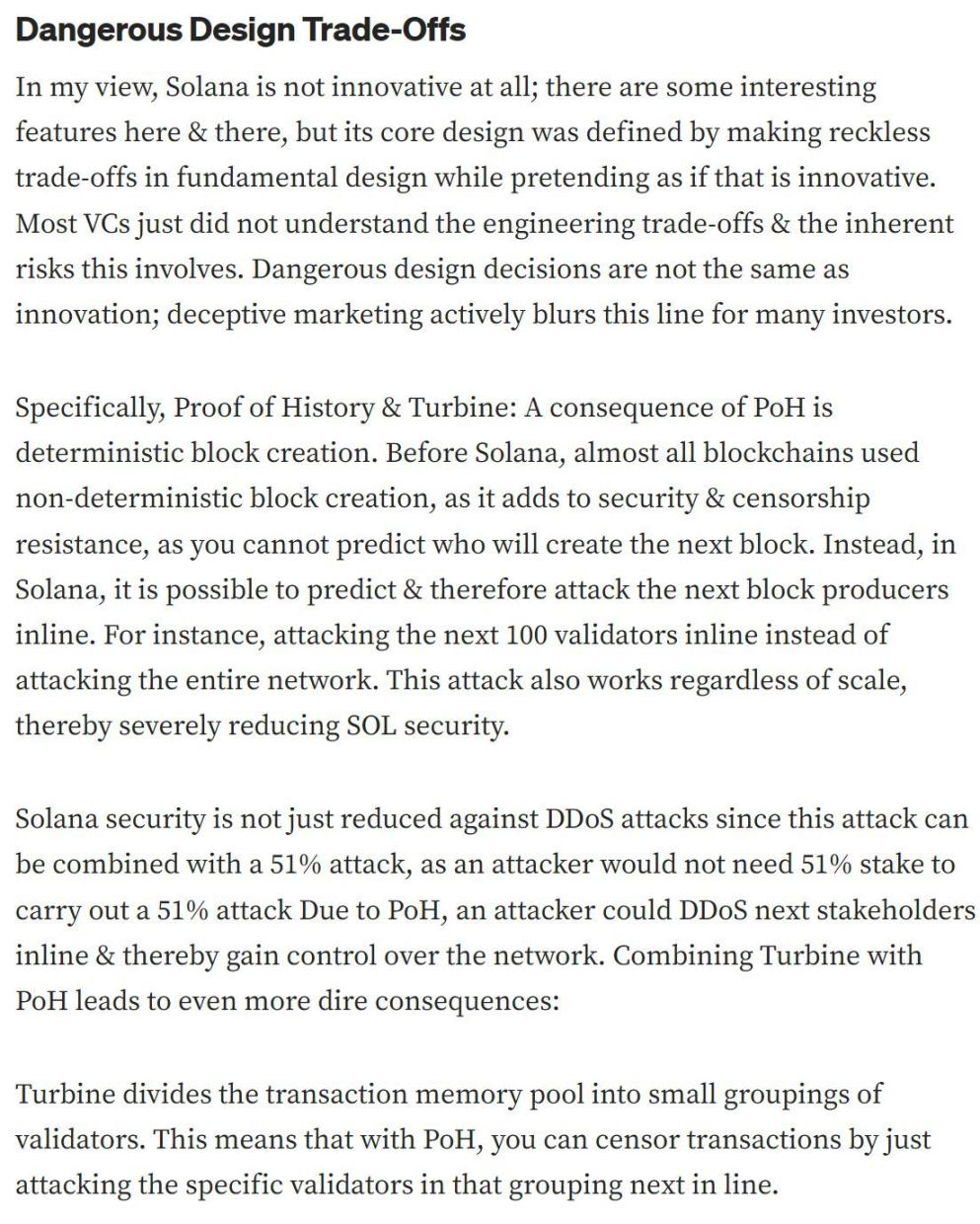
Source: Screenshot of the article "Criticism of Solana: Lies, Fraud, and Dangerous Tradeoffs"
Still, Solana has a market cap 3x that of the next L1 blockchain, and even with this tradeoff, Solana still has superior security. Is this particular tradeoff worth it? It’s hard to say.
However, what is certain is that Solana today is not unsafe, and a balance has finally been reached because from a practical point of view, Solana is much safer than its competitors with a closer market capitalization.
Decentralization is a concept that involves multiple interacting factors. For example:
A high-capacity blockchain with 10,000 nodes running on supercomputers is more decentralized than a low-capacity blockchain with only 100 nodes running on Raspberry Pis.
This is an extreme example, but it highlights my point. This is why, despite Solana’s high node requirements and centralized design decisions, it is actually very decentralized at scale. Because scale plays a big role in actual decentralization. Solana achieves this by distributing stake widely across 1,300 validators:
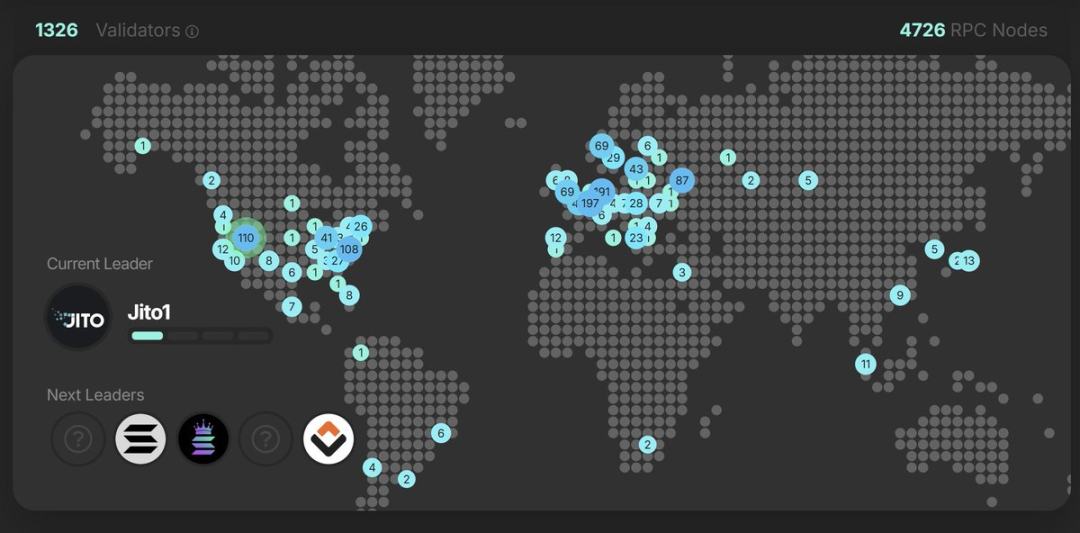
Source: Solana Beach
This actually confirms the long-standing theories and arguments around maintaining decentralization, which can be traced back to the block size dispute of Bitcoin. There has always been a tension between scaling and decentralization, which is most typically reflected in the "blockchain trilemma". The solution is to find the right balance between the two extremes, because being at either end of the spectrum will lead to failure, either being useless or too centralized.
So it’s a dream come true to see Solana deliver on this vision after Bitcoin and Ethereum moved away from it. Hopefully this better explains my shift as an old school big block Bitcoiner from 2013 and why I’m now supporting Solana.
Governance and Client Diversity
Solana has multiple competing clients, which is huge for decentralization. Without multiple clients, a blockchain is effectively a single-party governance system. You can vote, but there is only one party to choose from.
Multi-client also greatly increases the resiliency of the network, as it means that a single implementation vulnerability can no longer bring down the entire network.
Solana is one of the few blockchains that have been able to do this. Therefore, this achievement cannot be underestimated and demonstrates a strong commitment to decentralization. Because maintaining two clients is more than twice as difficult as maintaining one. This explains why few are willing to take this step, and they prefer to cover up obvious centralization issues while these "shadow rulers" pretend that this is a "meritocracy" system and they can control any changes.
Solana also has rudimentary on-chain governance mechanisms, which are still a work in progress, but the mere promise of that puts it well ahead of Bitcoin and Ethereum, which in my opinion are effectively dictatorships when it comes to making decisions about rule changes.
Solana’s recent failure to pass SIMD228 was a paradox, but it was actually a major milestone. Because disagreement and conflict are the hallmarks of true decentralization. Think about it… the proposal had the support of all of Solana’s top leadership, and yet stakeholders still rejected it. There is no better proof of true decentralization than this. Today, the checks and balances of good governance are truly working properly at Solana.
Off switch
This is a ridiculous claim, and one I never mentioned in my previous critiques, but it’s worth at least briefly addressing.
Solana does not have an “off switch.” Unlike permissioned chains (like XRP and HBAR) or chains with some permissioned elements (like ALGO and BNB), Solana does not have any permissioned elements and is a truly public, trustless, and decentralized blockchain, which is an undeniable fact.
This misunderstanding may stem from not understanding the difference between a blockchain being down and an actual off switch. Consensus mechanisms are complex, and there are many ways a blockchain can be down that are not the result of centralized control. I don’t want to waste time on this ignorant criticism, because anyone with a modicum of technical common sense knows the truth.
Fraud and lies
Fraud and lies are much harder to tolerate. As I said in my previous critique, the Solana team has a history of bad behavior over the years. However, the Solana team has indeed improved a lot in terms of honesty and professionalism in their communications since then.
However, the ugly truth is that in 2020, the Solana team did lie about the circulating supply. Even if these numbers are irrelevant to today’s market, it is undoubtedly still a stain on Solana’s history. In the interest of full transparency, I have elaborated on this in my previous critique, and I even included evidence:
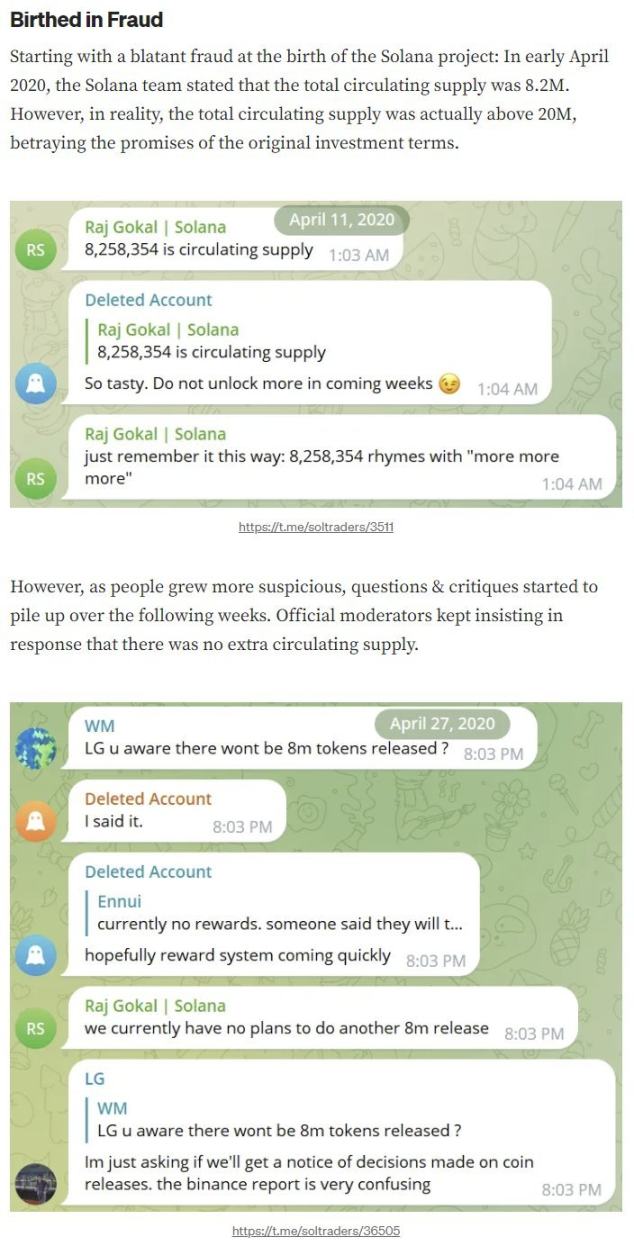
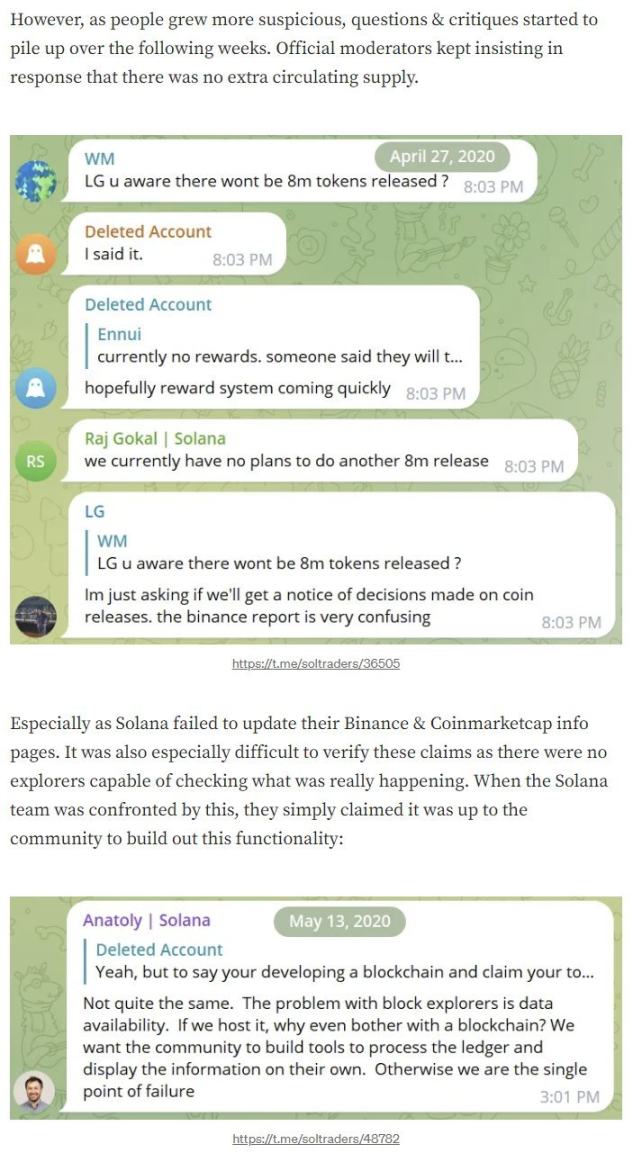
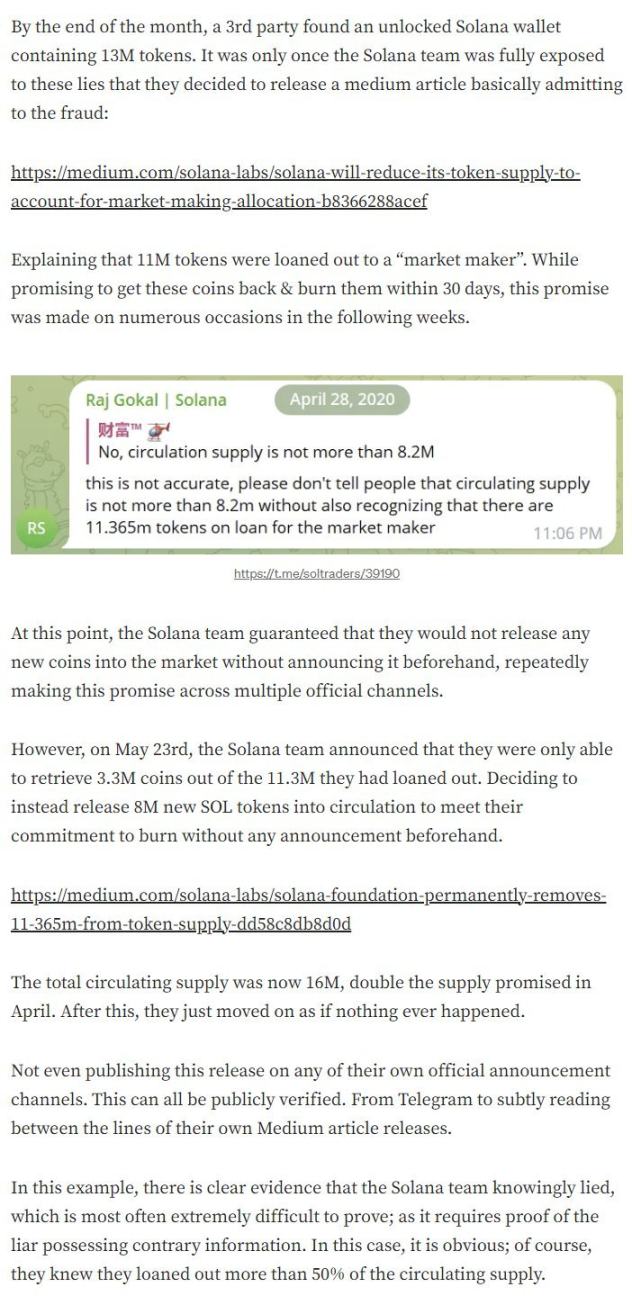
Source: Screenshot of the article "Criticism of Solana: Lies, Fraud, and Dangerous Tradeoffs"
My response comes down to the concept of decentralization: a blockchain can grow beyond the state it was founded in. Decentralization means Solana is not defined by its past leadership. Especially as mass adoption arrives, leadership will be diluted and change. This means that even if you don’t trust Solana’s current leadership, we can still support it.
Personally, I have regained confidence in its leadership now that the “bad behavior patterns” have stopped. But my main point is that you don’t actually need to trust leadership.
That’s what decentralization means: you don’t need to trust anyone! The mistakes of the past are still there, but we can look to the future.
Summary of previous criticisms
To summarize my past criticisms, as I did at the time:
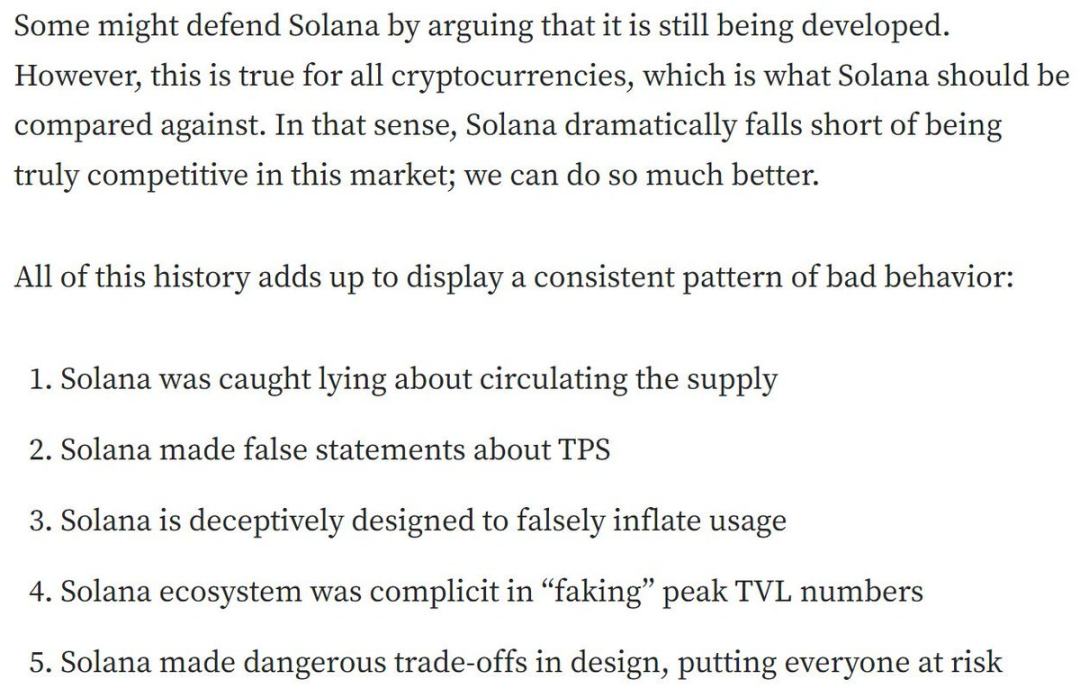
In 2020, Solana’s leadership lied about supply, but this has no material impact now.
Solana has improved external communications, and now real TPS is reaching new highs!
The blockchain browser now displays "Real TPS".
TVL is no longer “fake”.
Most dangerous trade-offs have been corrected
I have always been a staunch defender of crypto principles, and have adjusted my stance as cryptocurrencies have evolved. Some have accused me of being a shill because my shift in stance did seem so sudden.
This accusation is not only a personal attack, but also ridiculous on its face, considering how negative I have been about Solana in the past. Even if they wanted to buy people off, I would definitely be the last one to be bought off.
Perfect is the enemy of good
If we are too picky, the blockchain space will be fragmented into thousands of chains, which is not good for the development of cryptocurrencies. Or, at least, we should rationally distribute support in achieving the goals of the cypherpunk movement.
Remember, this is coming from someone who rejects 95% of blockchains. I even loudly criticized the #1 and #2 blockchains by market cap (Bitcoin and Ethereum) in 2016 and 2022 respectively for their deviations from the on-chain scaling path.
That’s why we better have a good reason to reject the third blockchain (Solana). I have a hard enough life, managing the oldest liquidity fund in the world and always taking a contrarian strategy. This is also why, in good conscience, I can no longer continue to criticize Solana because they have fixed the flaws I criticized... I have to become an admirer.
Even the most popular content I’ve ever published was critical of Solana. This caused a lot of my audience to hate me because of my change of stance, and many people in the Solana community are wary of me as a former critic. I guess, sometimes, this is the price of being a free thinker.
Sure, there may be better blockchains out there technically, but is the path to mass adoption as smooth as supporting Solana? I’d rather present real revenue numbers to my clients than theoretical numbers…
What’s important is that Solana is decentralized enough to achieve many characteristics such as censorship resistance, immutability, financial sovereignty, etc., and it is on a blockchain that can be used on a large scale today. This is the ultimate key.
in conclusion
As a value investor who supports the overall scaling theory, it is natural for me to support Solana as it gradually emerges.
Solana is far from perfect; even at the time, it wasn’t my favorite design. However, its success in use must be respected because that’s where the real value lies.
Scaling without decentralization is meaningless; vice versa is also true, of course, and while Solana’s opponents claim that it ignores this, that is not the case.
In an environment where Ethereum has decided not to scale at all on L1, Solana has emerged as the new king. Of course, there are certainly many competitors eyeing the throne, and diversification remains key. However, in the areas that really matter: utility, usage, and revenue, we can’t ignore Solana’s clear advantage in the market today.
Ignoring this at this stage either stems from a gross misunderstanding of Solana or its competitors, or simply bias. We all need to fix our damn biases! That’s why being able to change your mind is such a superpower in this industry.
As an early adopter of Bitcoin and Ethereum, I later became a critic when these blockchains deviated from the path of on-chain scaling.
Solana’s success is something we as cypherpunks should applaud because only through scalable technology can the masses be liberated, and Solana is now realizing this beautiful vision.
Perfection is the enemy of excellence, and Solana is excellent enough. You will fall in love with Solana just like me, if you choose to be free or die.














